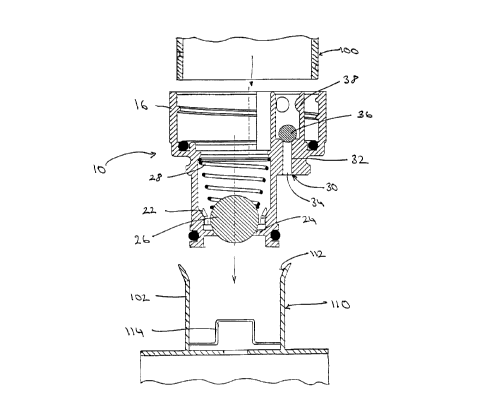Note : Les revendications sont présentées dans la langue officielle dans laquelle elles ont été soumises.
CLAIMS
Claim 1. A dispensing closure adapted to control the flow
of fluid from a container, said dispensing closure
comprising:
a housing adapted to be attached to the container;
a nozzle extending from said housing in fluid
communication with the container, said nozzle having a
valve assembly for selectively preventing fluid flow
through said nozzle; and
a vent formed in said housing proximate said nozzle,
said vent including a vent opening and a valve member for
selectively closing said vent opening.
Claim 2. The dispensing closure as defined in claim 1 and
further comprising a cap detachably mounted to said
closure, said cap enclosing said nozzle and said vent
opening to selectively prevent fluid leakage from said
closure.
Claim 3. A dispensing closure for selectively dispensing
fluid from a container into a receiving system, the
dispensing closure comprising:
a housing having an inner threaded surface for
threaded attachment to the container, and an outer surface;
a dispensing nozzle contained within the housing and
having a dispensing end and a receiving end,
a valve assembly for selectively dispensing fluid
through the nozzle, the valve assembly being contained
within the dispensing end of the nozzle;
7
a vent contained within the housing at a location
displaced from the nozzle.
Claim 4. The dispensing closure as described in claim 3,
wherein the dispensing nozzle is laterally displaced from
the vertical central axis of the housing.
Claim 5. The dispensing closure as described in claim 4,
wherein the valve assembly contained within the dispensing
nozzle comprises:
a circular aperture at the dispensing end of the
nozzle,
a valve ball sized to fit sealingly within the
circular aperture, and
a coil spring anchored within the receiving end and
the valve ball, the valve ball being biased against and
thereby selectively sealing the circular aperture.
Claim 6. The dispensing closure as described in claim 3,
wherein the vent comprises an opening and a valve member
for selectively closing the vent opening.
Claim 7. The dispensing closure as described in claim 6
wherein the valve member consists of a vent ball that rests
upon the opening within the vent.
Claim 8. The dispensing closure as described in claim 3,
further comprising a cap detachably mounted to the closure,
the cap enclosing both the nozzle and the vent.
8
Claim 9. A dispensing closure for selectively dispensing
fluid from a container into a receiving system, the
dispensing closure comprising:
a housing having an inner threaded surface for
threaded attachment to the container, and an outer surface,
the housing being substantially cylindrical about a central
vertical axis;
a dispensing nozzle contained within the housing and
having a dispensing end and a receiving end, the nozzle
being laterally displaced from the vertical central axis of
the housing;
a valve assembly for selectively dispensing fluid
through the nozzle, the valve assembly being contained
within the dispensing end of the nozzle and having: a
circular aperture at the dispensing end of the nozzle; a
valve ball sized to fit sealingly within the circular
aperture; and a coil spring anchored within the receiving
end and the valve ball, such that the valve ball is biased
by the spring against the circular aperture, thereby
sealing the aperture; and
a vent contained within the housing at a location
displaced from the nozzle, the vent comprising an opening
and a valve member for selectively closing the vent
opening.
Claim 10. The dispensing closure as described in claim 9,
wherein the valve member of the vent consists of a vent
ball that rests upon the opening within the vent.
Claim 11. The dispensing closure as described in claim 9,
further comprising a cap detachably mounted to the closure,
the cap enclosing both the nozzle and the vent.
9
Claim 12. The dispensing closure as described in claim 9,
wherein the dispensing nozzle is integrally molded within
the housing, and wherein the vent is formed within the
housing at a location displaced apart from the dispensing
nozzle.
10
